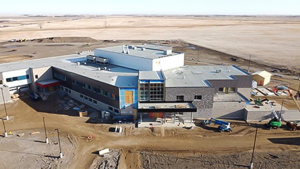OTTAWA — BuildForce Canada expects Manitoba’s ICI sector to experience moderate but sustained employment growth between 2025 and 2030 while elevated levels of activity in both the residential and non-residential sectors in Saskatchewan should continue through 2032.
The forecasts come from the agency’s 2023-2032 Construction and Maintenance Looking Forward reports for the two provinces released April 26.
The outlook calls for a moderate contraction in employment in Manitoba across the forecast period (minus one per cent), as a contraction of just below three per cent in the residential sector more than offsets a slight increase of just below one per cent in the non-residential sector.
Across the forecast period, the non-residential sector should see moderate but sustained employment growth between 2025 and 2030 as a series of projects cycle up and down.
“Construction activity in Manitoba should remain at a relatively constant and elevated level across the 10-year forecast period,” said Bill Ferreira, executive director of BuildForce.
“It also means that the industry should be able to satisfy its hiring requirements, given the province’s comparatively younger demographic.”
BuildForce expects approximately 7,600 workers, or nearly 19 per cent of Manitoba’s 2022 labour force, will retire by 2032.
At the same time, the industry is expected to attract an estimated 8,700 new workers under the age of 30 from the local population. This trend shows industry efforts to boost recruitment to meet future needs are working, and that the industry should be able to meet its anticipated labour force demands throughout the forecast period.
Ramona Coey, executive director of the Mechanical Contractors Association of Manitoba, commented, “After years of declines, it was encouraging to see industry efforts to promote careers in the trades bearing some fruit as evidenced by the recent upswing in new registrations in Manitoba’s 17 largest trade programs.”
Trades at risk of potentially undersupplying the number of new journeypersons required in Manitoba by 2032 include bricklayer, carpenter, mobile crane operator, roofer and welder.
Women represented just four per cent of the 38,600 tradespeople employed in Manitoba’s industry in 2022, unchanged from 2021.
Saskatchewan’s construction sector is in the midst of a sustained period of growth, as elevated levels of activity in both the residential and non-residential sectors should bring work to a peak in 2024. Market conditions should ease thereafter but remain elevated by historical standards through 2032.
BuildForce expects activity in the non-residential sector in Saskatchewan will remain elevated through 2024, supported by new and ongoing manufacturing, utility, mining, school and health care projects, before slowing to 2026 as many of those projects conclude.
After posting an increase of six per cent in 2022, employment demands are expected to grow by a further eight per cent to a peak in 2027, before contracting across the remainder of the 10-year forecast period. By 2032, overall employment is expected to rise by three per cent.
Ferreira said Saskatchewan’s residential sector will be a real driver of growth for Saskatchewan’s construction sector through most of the forecast period. The outlook for the non-residential sector, on the other hand, is more closely tied to selected major projects, including the Jansen potash mine.
Such growth could strain already challenged labour markets. Entering the forecast period, many of Saskatchewan’s residential and non-residential trades and occupations were experiencing tight labour markets. Meanwhile, employment is outgrowing the labour force, reducing the industry’s annual average unemployment rate to 6.3 per cent in 2022.
Across the forecast period to 2032, BuildForce anticipates that as many as 8,600 workers, or 21 per cent of the province’s 2022 construction labour force, will exit the industry through retirement. At the same time, demand growth will require the addition of 2,200 workers, bringing the total recruitment requirement to 10,800 workers.
Given the province’s comparatively younger demographics, most of the industry’s hiring requirements could be met by an estimated 9,500 first-time new entrants under the age of 30 from the local population. This would leave a gap of about 1,300 workers that will need to be recruited from outside the local construction labour force.
Several trades may be at risk of undersupplying the number of new journeypersons required by 2032. These trades include boom truck operator, bricklayer, carpenter, construction electrician, insulator, sheet metal worker, steamfitter, pipefitter and and welder.











Recent Comments
comments for this post are closed